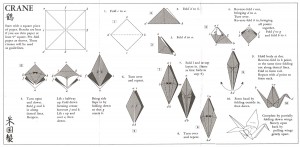I figured I’d start my origami experience with something basic, so I decided to show you all how to make paper stars. They’re really easy and fun, and I ended up making a whole lot while watching “Between the Folds.”
More Origami
Robert J Lang talks about his artistic process as an origami artist:
Some examples of origami replacing other soft materials in clothing and fashion:
Trying my hand at folding bluebirds:
Simple instructions: http://www.origami-fun.com/origami-bird.html
Archigami
http://www.thecoolist.com/papercraft-perfection-10-amazing-master-origami-artists/
I first came across this website and learned about a variety of artists who use paper as their primary medium, along with origami artists, I read about the multitude of techniques within origami.
I found Ingrid Siliakus and Richard Sweeny’s work to be most intriguing.

Ingrid Siliakus makes sculptural forms out of paper. This is a unique form of origami because in a sense it represents a contradiction, as well as a way to take architecture out of its normal context. Architectural structures are typically thought to be concrete, yet these structures are simply made from paper therefore it brings on the question of whether Ingrid’s sculptures are simple mecets of structures, or architectural structures themselves.

Richard Sweeny creates sculptural geometric forms possessed an elegance that one typically does not allocate to paper.
I then decided to look up how to go about making these two types of origami styles, and found these tutorials to be the most helpful:
http://www.youtube.com/embed/dnU6TgFfP
(this type of origami is considered “Kirigami”)
Inspirational Artists for Soft Sculpture
Here are the two artists I would like the class to look at; Christo & Jeanne-Claude and Do Ho Suh.
Using fabric, the couple have been creating work on a gigantic scale. Their main work includes Wrapped Reichstag in Berlin, The Gates in Central Park, NYC, and Over The River in Colorado.
Some of Do Ho Suh’s installation work such as Home within Home and Reflection were made of synthetic resin and polyester fabric.
http://www.lehmannmaupin.com/artists/do-ho-suh
Origami Box
Of course, I found this instruction from Google. Folding paper to make a box can seem easy and basic, and yet this will be a fundemental starting point where a 2D transforms into a 3D. So, let’s make one. Also, what I found quite surprising about origami is that it has roughly 400 years of history, and it’s now classified as a modern art form. Origami is definitely more than just folding papers!
Vessels and Tessellation
I came across these really beautiful origami vases and vessels by Rebecca Geiseking. I don’t quite know how to explain it, but it almost feels like her work is breathing. You can see her flickr here.
I’m really interested in Oragami tessellations also. I found this handy little basic reference for it here (pay attention to the page numbers, it was intended to be printed and made into a book, so if you are reading it online, the pages are out of order. I’ve been fumbling around with it, but to limited success. Very interested in experimenting with rastering the pre-creasing with the laser cutter.
Here is a nifty little time lapse of a really intense tessellation. There are also a bunch of tutorials on youtube if you poke around.
Paper Cranes
I decided to show the class how to fold paper cranes. I have this habit of doing something with my hands whenever I have the slightest chance to. And the most common thing I seem to do is either make a paper airplane or paper cranes with any spare paper lying around.
Inspiring Paper Art Works
I’ve always been fascinated by this idea of transition from a flat piece of paper to such dimensional object. I found some inspiring paper art forms. Here is one very complex piece by Richard Sweeney from this website on “100 Extraordinary Examples of Paper Art”.
http://www.webdesignerdepot.com/2009/05/100-extraordinary-examples-of-paper-art/
And here is a very contrasting piece by Jen Stark. This piece doesn’t have complex angular planes as Sweeney’s piece, but rather build from repetition of planes, slightly changing in angle.
<http://www.webdesignerdepot.com/2009/05/100-extraordinary-examples-of-paper-art/> shows many more inspiring artists.
Sculptors
Tim Prentice:
particularly ‘Biplane’, ‘Proposal’, and ‘Yellow Zingers’
his works aren’t necessarily soft (this particular one is made from woven toothpicks), but they have a similar soft, organic appearance to Ernesto Neto’s work







